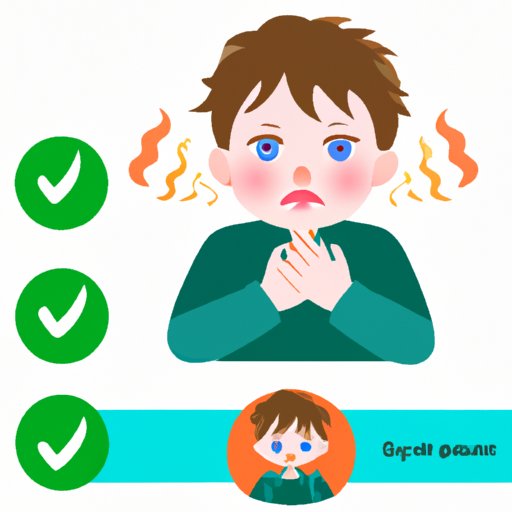
I. Introduction
Rabies is a lethal virus that affects both humans and animals. Understanding the symptoms of this disease is crucial to ensure timely medical intervention and prevent the spread of the virus. In this article, we will take a comprehensive look at the symptoms of rabies, including how it spreads, stages of the infection, and early warning signs.
II. Understanding the Symptoms of Rabies: A Comprehensive Guide
Rabies is a viral infection that affects the brain and nervous system of humans and animals. The virus is usually transmitted through the bite or scratch of an infected animal and can also be spread through contact with the animal’s saliva.
There are two forms of rabies infection: Furious and Paralytic. The Furious form is the most common, and symptoms usually appear within 3-8 weeks after exposure. On the other hand, the Paralytic form can take several months to show symptoms and is less frequent.
When a person or animal is infected with rabies, the virus progresses through three stages: Prodromal, Furious, and Paralytic. During each stage, different symptoms are present, making it essential to be familiar with each stage to recognize the onset of symptoms.
III. Don’t Ignore These Warning Signs: Common Symptoms of Rabies
Although the symptoms of rabies may vary among individuals, there are some common signs to look out for. Common symptoms of rabies in humans include:
- Fever
- Headache
- Nausea and vomiting
- Agitation and anxiety
- Muscle weakness
- Confusion and hallucinations
- Hyperactivity and aggressiveness
The virus affects the brain and nervous system, leading to confusion and aggression in some individuals. It also affects the ability to swallow and breathe, causing an impending feeling of suffocation. If left untreated, the virus can cause fatal damage to the body’s vital organs.
If you or a loved one experiences any of the symptoms mentioned above, it is essential to seek medical attention immediately. Rabies is a medical emergency, and early treatment is critical to prevent the onset of severe symptoms.
IV. What to Look Out for: Recognizing the Symptoms of Rabies in Animals
Rabies can infect almost any mammal, with dogs, bats, and raccoons being the most common carriers of the virus. Common symptoms of rabies in animals include:
- Aggression and restlessness
- Excessive drooling or foaming at the mouth
- Unusual behavior, such as nocturnal animals active during the day or friendly animals acting aggressively
- Muscle paralysis
- Dilated pupils and loss of coordination
- Convulsions and seizures
It is essential to be cautious around animals displaying strange behavior and avoid contact as much as possible if an animal is suspected of having rabies. Additionally, avoid touching wild or stray animals to reduce the risk of exposure to the virus.
V. Stay Alert: How to Spot the Early Symptoms of Rabies
Recognizing the early symptoms of rabies is crucial, as early diagnosis can help prevent the virus from progressing and potentially save lives. Some of the most common early symptoms of rabies in both humans and animals include:
- Fever and headache
- Malaise and fatigue
- Muscle weakness and soreness
- Restlessness and agitation
- Loss of appetite and nausea
- Tingling and itching at the site of infection
If you or a loved one experiences any of these symptoms, it is critical to seek medical attention immediately and notify the healthcare provider of potential rabies exposure.
VI. The ABCs of Rabies Symptoms: An Easy-to-Read Guide
Here is a quick reference guide to the symptoms of rabies:
- Prodromal Stage: Early symptoms, including fever, headache, and muscle weakness
- Furious Stage: Agitation, hyperactivity, aggressiveness, and confusion
- Paralytic Stage: Muscle paralysis, seizures, and coma
- Common Animal Symptoms: Aggression, foaming at the mouth, muscle paralysis, and seizures
- Early Symptoms: Fever, headache, muscle weakness, restlessness, and loss of appetite
By being familiar with these symptoms, you can quickly identify potential cases of rabies in both humans and animals, allowing for timely diagnosis and treatment.
VII. Protect Yourself and Your Pets: Knowing the Symptoms of Rabies
Vaccination is the most reliable way to prevent a rabies infection. Both humans and animals can receive vaccinations to prevent exposure to the virus. It is also essential to avoid contact with wild or stray animals and properly secure pet vaccinations.
If you or someone you know has been bitten or scratched by an animal, it is crucial to seek medical attention and notify your healthcare provider of potential rabies exposure.
For more information on rabies prevention and treatment, visit the Centers for Disease Control and Prevention (CDC) website or speak to your healthcare provider or veterinarian.
VIII. Conclusion
Rabies is a life-threatening virus that requires urgent medical attention upon onset of symptoms. By understanding the symptoms of rabies, you can protect yourself and your loved ones from this deadly disease. Know the warning signs, stay alert for early symptoms, and seek medical attention promptly if you suspect rabies exposure. Together, we can prevent the spread of this disease and keep our communities safe.




